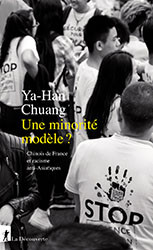Ya-Han Chuang
Interview with Ya-Han Chuang, a post-doctoral fellow at INED and author of Une minorité modèle ? Chinois de France et racisme anti-Asiatiques.
(Interview conducted in July 2021)
You’ve recently written a book on anti-Asian racism. How did you get started on this project?

When I began my PhD thesis, I realized that little was known about Chinese immigrants living in France, so I decided to concentrate on the immigrant population from continental China. I spent the first two years on my doctoral work on the migration process, after which I focused on collective mobilizations (strikes, demonstrations) and how they are impacted by work organization.
When the French fashion designer Chaolin Zhang died after being attacked in Seine-Saint-Denis, people started talking about anti-Asian racism.
In 2019, I submitted a project to Éditions La Découverte publishers for a book entitled Une minorité modèle ? Chinois de France et racism anti-Asiatiques [A model minority? The Chinese population of France and anti-Asian racism]. I wanted to account for the living conditions of Chinese immigrants, a group often thought of as a model population. That positive stereotype tends to conceal the racialization mechanism at work and the discrimination to which these people are subjected.
How did you conduct your research?
I conducted a long-term ethnographic study to identify the different groups of immigrants, to analyze their different reasons for migrating and migration trajectories, and to observe connections between social class relations and occupational integration as well as the impact they had on people’s trajectories.
The aim was to study how the economic structure creates stereotypes of Chinese society; also how it gives rise to collective mobilizations.
I kept track of my respondents over several years—some since 2009—which enabled me to retrace their trajectories, including undocumented immigrants who became entrepreneurs and students implicated in mobilizations who became elected officials, to name only two trajectory types.
How has the COVID-19 pandemic impacted anti-Asian racism?
Perceived by some as responsible for the worldwide pandemic, Asian-type people were targets of aggression during the health crisis we’ve been going through and continue to go through. COVID-19 revealed persistent stereotypes about the Asian community and gave new scope to the issue of anti-Asian racism.
